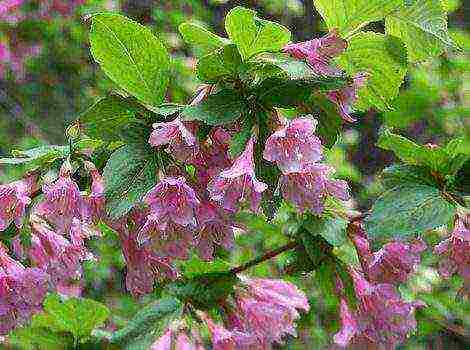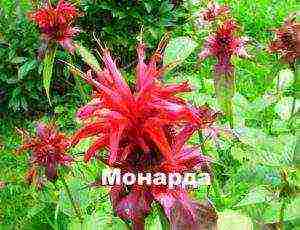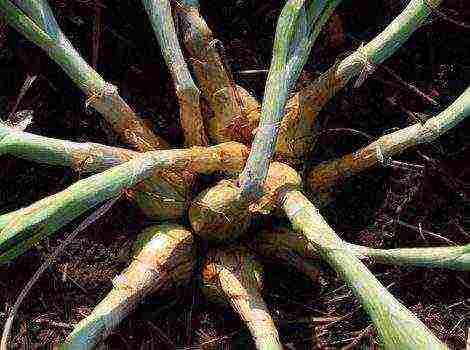Content
The American state of Illinois, with its hot, humid summers, devastating tornadoes and winter snowstorms, is home to many modern garden blackberry varieties.
It was there, at the University of the city of Carbondale, by hybridizing the Darrow variety with Thornfrey and breeding number US1482, the superstar of Russian gardens, Black Satin, was obtained. Zoned initially for Illinois and California, she very quickly took possession of planting areas throughout Europe and acclimatized in Russia.
Description of the variety
Let's start by describing the variety of berries. Black Satin in form occupies an intermediate position between kumaniks and dews. This is a semi-creeping variety, the main characteristics of which are collected in the table:
| Habit | Strong shrub, not prone to thickening. Does not form root offspring. |
| Escapes | The shoots are fast-growing, with a round cross-section, thornless, very long - up to 5 meters. At the beginning of growth - erect. When they grow beyond the 1.5 meter mark, they begin to creep. Young vines are green and turn brown as they mature. Second years are brown, very tough and thick - up to 3 cm in diameter. The leaf is complex, serrate, from 3-5 leaf plates. |
| Bloom | The flowers are pink when blooming, the next day they fade to pale pink or white. |
| Fruiting | Exceptionally abundant. The berries are large, up to 8 grams, black, with a satin gloss, which is why the name of the variety appeared. The taste is excellent, sweet and sour, with a strong blackberry aroma. Ripening is extended, from August to October. Some fruits catch the first snow. It starts bearing fruit the next year after planting. |
| Sustainability | Frost resistance is moderate, up to -22⁰C. The tops of the shoots may freeze slightly. Shelter is required for the winter. May be affected by gray mold. |
| Yield | Very high - up to 25 kg of berries per bush per season. |
| Purpose of fruits | Universal. |
| Transportability and keeping quality | Both indicators are low. Ripe fruits are soft, quickly lose their presentation and deteriorate. |
Thus, the Black Satin variety has many advantages:
- large berries of excellent taste and universal use;
- high productivity;
- spineless shoots;
- controlled density of the bush.
Of the minuses, you can name:
- poor keeping and transportability of fruits;
- insufficient frost resistance;
- instability to gray rot.
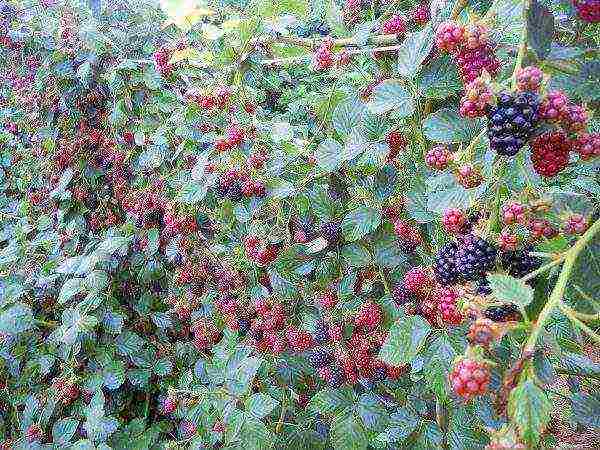 Bush with berries Black Satin
Bush with berries Black Satin
However, these disadvantages can be easily corrected. For example, gray rot affects overripe berries, and it is enough to remove them from the bush in time to avoid this. Extended fruiting allows you to approach the plant every three days and take a small amount of fruit, immediately eating it or putting it into processing.
With regard to transportability, according to some observations, this indicator increases significantly with the age of the plant. A berry from an old bush of a denser structure, does not choke so easily and, with dexterous collection, can survive a short journey.
Black Sateen's penchant for a gradual yield is both a plus and a minus. In regions with an early onset of winter, the variety may not have time to show everything it is capable of.
Planting and leaving
It is better to choose a place for planting Black Satin blackberries, which is sunny, protected from drafts, with light fertile soil. This variety does not tolerate stagnant water, therefore, drainage must be done on wet soils.
It is better to place seedlings in a permanent place in the spring. However, if the planting material is purchased in the fall, it does not matter: when planting a plant in the fall, you need to take care of its shelter and care.
The planting pit is prepared in such a way that it is possible to fill it up to half with good mature compost. Already when disembarking, you need to take into account the need for a garter of blackberry lashes and make a support.
The vigor of Black Satin is a double-edged sword. On the one hand, this allows good harvests. On the other hand, it creates difficulties for the shelter of an adult plant for the winter. The shoots of this blackberry bend very badly. There are two ways out.
 Bunches of Berries Black Satin
Bunches of Berries Black Satin
"Education" of the correct position of the vine
Do not allow the plant to push upright shoots too far. Already when they reach a length of 35-40 cm, it is necessary to bend the branch to the ground and so fix it. When the vine is 1.2 meters long, you can free it and put it horizontally on the trellis. For the winter, the bent shoot can be easily removed and placed under the shelter.
American pruning
At home, the Black Satin blackberry is formed in the form of a compact bush according to the following scheme:
- in the middle of summer, in annual increments, pinch the tops at a height of 110 cm, stimulating the growth of lateral shoots;
- in early spring, before the buds awaken, the lateral shoots are normalized: those growing below the 45-centimeter mark are removed from the ground, the rest are shortened to a length of 40 cm;
- in the fall, the branches that bear fruit are cut out.
It is necessary to remove the spent "fruit" in any case. The blackberry vine, like the raspberry vine, has a two-year development cycle, and after the second year it will only thicken the bush and contribute to the spread of gray rot.
Watering Black Satin blackberries is necessary regularly, especially when pouring fruits. She will respond to drought by chopping berries. Waterlogging of the soil should also be avoided.
To obtain good annual yields, blackberries need to be fed from the third year of life according to the scheme:
- Spring - nitrogen (5 kg of humus and 10 g of urea per 1 m2);
- autumn - potassium and phosphorus (100 g of superphosphate and 25 g of potash fertilizers).
Blackberries should not be planted next to raspberries. Being close relatives, raspberries and blackberries suffer from the same diseases, and such a neighborhood can cause an "epidemic".
Diseases and pests
Basically, this variety is resistant to major blackberry diseases. The exception is gray rot, which has already been mentioned. Its causative agent, botrytis gray, is a mold that is used in winemaking.
It can hit the plant already in the flowering phase. If the weather is cold, rainy, whole inflorescences may suffer. In the later stages of the growing season, Botrytis sits on ovaries and fruits. A berry sick with gray rot looks like a rotten one, covered with gray fluff. Therefore, it is better to take preventive measures in advance than to lose the crop.
- The lower branches should not lie on the ground. Botrytis spores are stored in the moist ground.
- The bush must not be allowed to thicken. All vegetative parts of the plant must be ventilated.
- Timely remove ripe berries and remove rotten ones. Having found a diseased shoot, cut it out and burn it.
- In the spring, before flowering, spray the bush with Bordeaux liquid (3% solution).
Of the pests for blackberries Black Satin, the danger is the blackberry mite. This tiny insect is capable of halving the berry crop. Unlike many other pests, the mite does not hibernate in the soil or under the bark. It settles directly in the buds of blackberries, and in the spring migrates to inflorescences and berries. The fruits affected by this pest do not ripen, remaining reddish.
You can fight this scourge with the drug "Tiovit Jet", which is usually used to treat grapes. Spraying should be done before bud break.
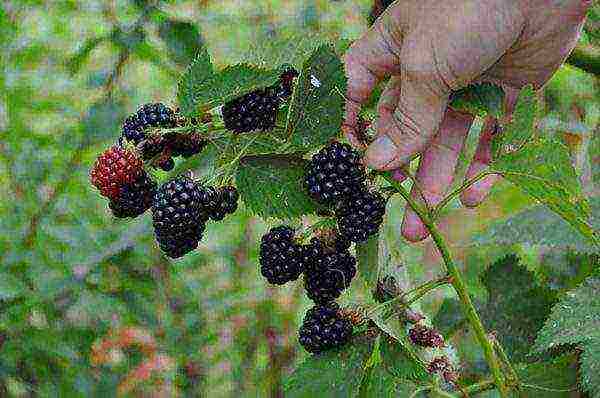 Sprig with juicy berries Black Satin
Sprig with juicy berries Black Satin
3 facts about blackberry Black Satin
- Researcher Fumiomi Takeda from the Appalachian research station has been experimenting with this variety. Blackberries were divided into groups, forming them with different number of lashes: 3, 6, 9 and 12. The aim of the experiment was to determine whether the number of shoots affects the yield of the plant. The result turned out to be interesting: in terms of total weight, Black Satin gave absolutely the same result in all groups. The difference was in the size of the berries.
- Working with experienced blackberry plantations Black Satin, the same Fumiomi Takeda invented the swivel trellis. This device allows you to cover the plant for the winter without removing the lashes from the garter. It is enough just to transfer it from the "summer" position to the "winter" one.
- It's believed that Black Satin is difficult to breed as it does not produce root suckers. However, the practice of experienced gardeners shows that this variety is easily rooted by the tops of the shoots. A good lower lateral shoot is selected, pressed to the ground, secured with a bracket, buried in. The procedure is performed in the middle of summer. In the fall, you can separate the seedling from the mother plant and place it in a permanent place.
Trellis growing of Black Satin blackberries has a special advantage: it allows you to create beautiful arches on the site, braided with blackberry vines. Given the ability of the variety to preserve foliage for a long time, such a design will not lose its decorative effect until late autumn.
Blackberry Black Satin is a good choice for berry bushes lovers. High productivity, fruiting period from late July to September, frost resistance are the big advantages of a thornless, unpretentious variety. Prefers a moderately mild climate, in the northern regions it requires shelter for the winter.
Description of the variety
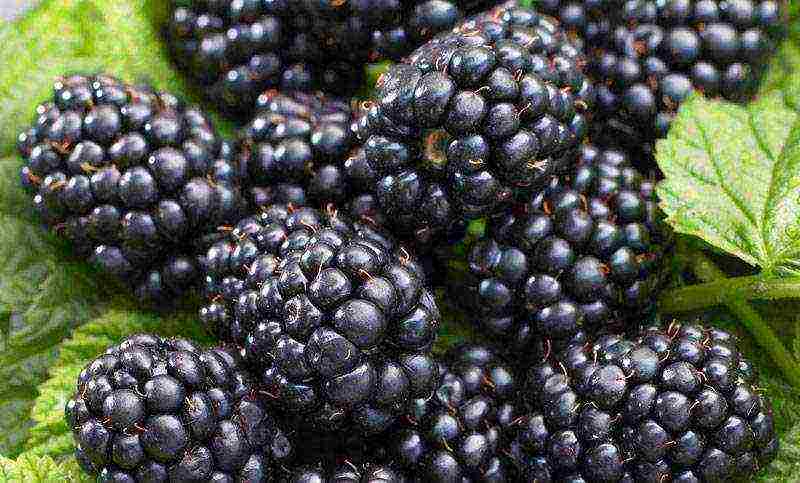 Photo Black Satin
Photo Black Satin
Black Satin - translated from English - Black silk. The culture owes its name to Dr. Scott, who in 1974 bred a variety with a soft, silky taste. The progenitors were Darrow and Thornfrey, who gave the blackberry the best qualities.
Fruit
Berry picking is carried out every 3 days, otherwise part of the crop overripe and loses quality. For an industrial scale, this is inconvenient, for a personal plot - providing fresh berries for the entire season.
Characteristic:
- Weight ranges from 4 to 7 g, with larger fruits on the tops.
- The sizes are medium, the berries become smaller and more dense over the years.
- The color is black in ripe fruits, with a glossy sheen.
- The shape is rounded, slightly elongated, the separation is tight.
- The consistency is very tender, the ripe fruit is easily wrinkled;
- Sugar content 13-14%, vitamin C - 15 mg per 100 g of raw materials.
- The taste is deep, balanced, sweet with a slight sourness and characteristic aroma.
- The purpose is universal, they are eaten fresh, they make preserves, jams.
- Loss is possible during transportation.
Bush
The culture is semi-spreading, thick shoots first grow upward, after 150 cm, under their own weight, they bend and spread along the ground. Their color changes from dark green to yellow-brown. Bright green leaves, collected in three, purple-white flowers give the shrub a decorative effect.
The height of the bushes reaches 5-7 m, so it is advisable to use a trellis to form a support. If the blackberry needs shelter for the winter, the plant is given a horizontal position. Black Satin is a variety prone to remontant; in August, shoots often develop from replacement buds, on which flowers and ovaries are formed.
Flowers appear in late May - early June. Violet-pink at first, the petals then take on a white tint. Due to self-pollination, many fruits are tied, berries are collected in clusters of 10-15 pieces.
Yield
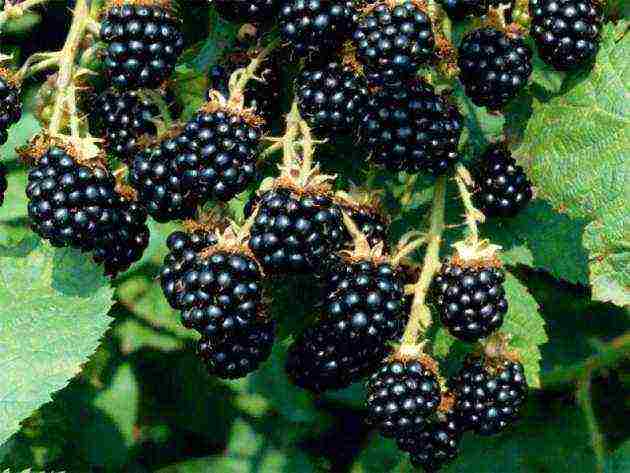
The ripening process of Black Satin berries continues continuously throughout August and September. Ripe fruits and fresh ovaries are located on one cluster. NSPermanent harvesting as a result gives from 10 to 15-20 kg per season from a bush.
The culture begins to bear fruit in the second year. For transportation, the fruits that have reached technical ripeness are removed, transported carefully because of the tender pulp, the harvest is not stored for more than a day.
Ripe berries are consumed immediately, fresh or processed into compotes, jams, juices, preserves. It is not recommended to leave ripe blackberries on the shoots - this provokes damage to the plant with gray rot. Harvested from mid-August to late September.
Distribution, winter hardiness
In the southern regions, the shrub develops well and easily tolerates the winter, responds to care with a generous harvest, large berries. In areas with a temperate climate, Black Satin winters without consequences, if the cold period passes mildly, and the frosts are not lower than -22 ° C, protection from cold weather is required only for seedlings of the first year of life.
In the northern regions, the harvest is lost by 10-15%, when early frosts in September suppress the ripening of the berries. It requires shelter for the winter in areas with a harsh climate, after pruning, the bushes are removed from the trellises at the end of September and laid on the ground, the shortened shoots are carefully collected in bunches, covered with fallen leaves, spruce branches, spunbond.
Growing
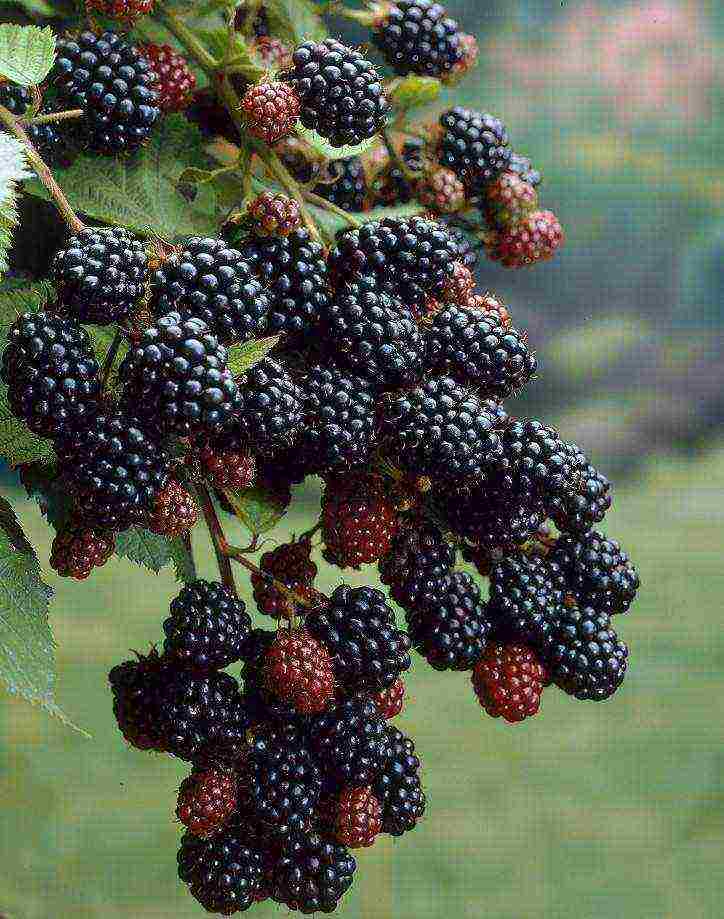
The unpretentious Black-Satin variety grows on any soil, but prefers fertile black soil. When planting, avoid places where moisture accumulates, salty and limestone soils cause yellowing of shoots and foliage.
Blackberry Black Sateen bears fruit well and develops in sunny areas, protected from the winds by fences, trees, buildings. Distance from other migratory crops and berries is at least 50 m.
In the northern regions, spring planting is practiced; autumn is suitable for a temperate and southern climate. In early spring, the procedure is carried out even before the buds swell, and in the fall - in the last decade of September. A shrub can be transplanted if done before flowering or after harvest.
Site preparation, material selection
The soil is prepared in advance. They dig a bayonet to a depth, remove weeds, fertilize poor soils with humus, 5-7 kg per 1 sq. m. Fertile soil does not require fertilization, this will cause excessive overground development of the plant, flowering, which will weaken it.
Saplings are chosen healthy, strong, without damage and traces of diseases and pests. Amateurs breed the culture with the tops of the shoots, achieving their numerous appearance by pinching a powerful replacement shoot.
Landing
A distance of about 2 m is maintained between the bushes, the row spacing is at least 1.5 m. If fertilizers are applied directly into the hole, they are mixed with the removed soil to avoid root burns.
How to plant Black Satin:
- Dig a hole 40-60 cm wide, long, deep.
- Consider the need for a garter support.
- The wells are watered abundantly.
- Fill up to half with soil mixed with compost.
- The seedling is placed at the bottom of the hole, trying not to damage the earthen lump on the roots.
- They fill the hole with soil, do not leave air spaces between the roots.
- The root collar is not buried; it remains above the ground surface.
- The soil is compacted and watered.
- The trunk circle is covered with a layer of mulch.
- The twigs are pruned, leaving no more than three buds on the shoots.
Black Satin Care
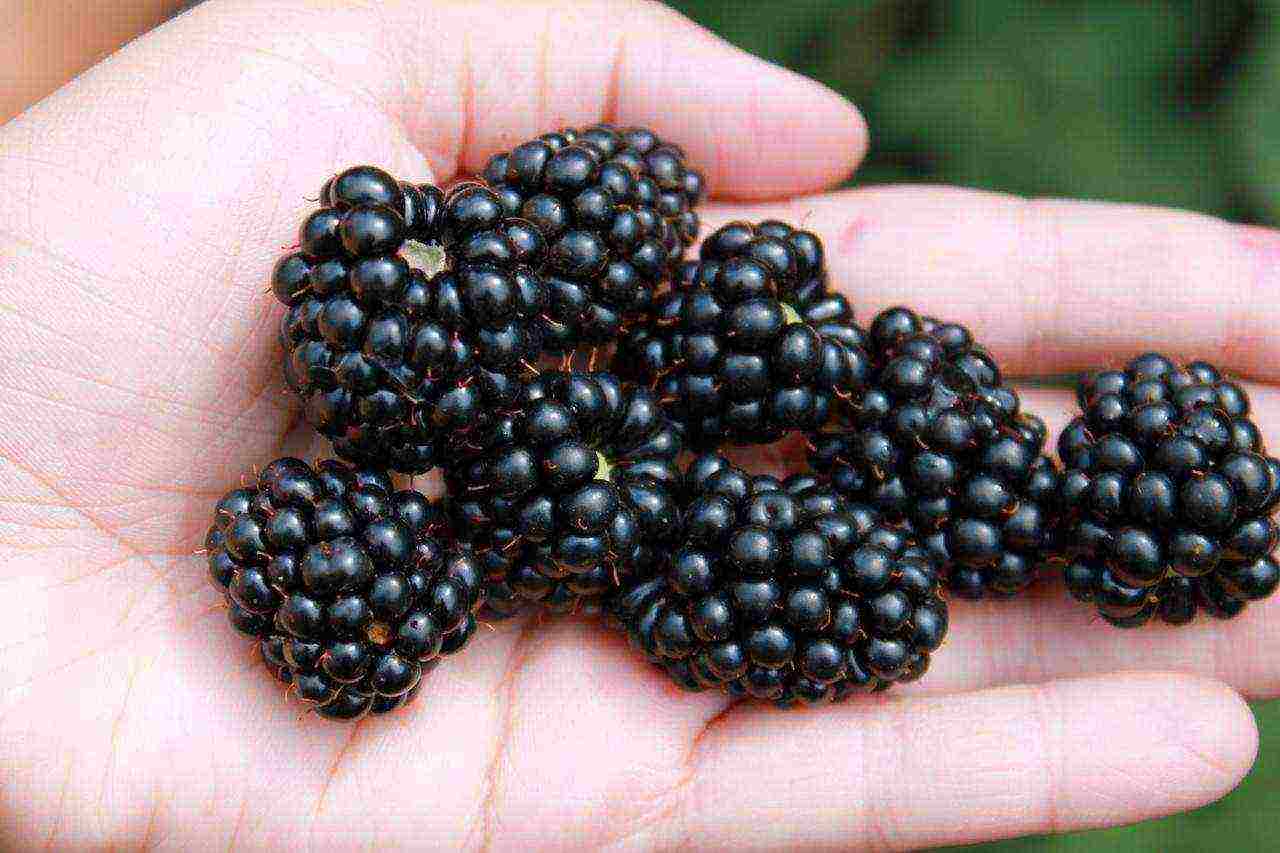
The blackberry vine has a two-year development cycle, like the raspberry. Removal of used branches - prevention of thickening and gray rot infections.
Pruning
In the fall, the branches from which they were harvested are harvested. Young shoots are completely removed at a height below 45 cm from the ground. The rest are trimmed, leaving 40 cm in length. In the spring, pruning of frozen branches is carried out.
To form a bush, the vine is given the desired position from the first year of life, pinned to the ground with a spear, since the vigorous bushes do not subsequently bend, break. In the future, such a bush is released when it reaches a length of 120 cm. It is easy to lift it on a trellis in the spring and lower it to the ground for wintering.
Watering and loosening
Excess moisture in the soil leads to decay of the roots and inhibition of development and growth. Regular watering is necessary when the berries are being poured; up to two buckets of water are poured under one adult bush during a drought.
In row spacings, plowing is carried out to a depth of 15 cm, breaking the crust that appears on the surface after watering or rain. Around the bushes, a layer of soil is loosened by 7-8 cm. Mulching with manure, peat, straw is useful. Plugged weeds, laid on top of the mulch, prevent excessive evaporation of moisture.
Top dressing
In the first year after planting, the shrub is not root-fed. The foliar method is recommended - spraying the leaves with a solution of Kemira Plus, 20 g per 10 liters of water.
For 2-3 years after planting, top dressing begins: 20-25 g of saltpeter, 10-15 g of urea per 1 sq. m. In the fall, fertilize with organic matter - 5 kg manure per 1 sq. m. m. or 100 g of superphosphate, 30 g of potassium sulfate per 1 sq. m. The shrub is preliminarily watered. It is taken into account that an excess of nitrogen fertilizers in autumn feeding has a bad effect on frost resistance.
Diseases, pests
The variety is resistant to infections with infectious diseases. The exception is gray mold caused by mold. The plant is especially strongly affected in the rainy season, whole clusters of inflorescences die.
Preventive measures will save you from crop loss:
- The shrub is sprayed with a 3% solution of Bordeaux liquid in the spring, before flowering.
- Ripe fruits are removed regularly and on time. Berries with rot are immediately burned.
- Do not allow constant contact of the lower shoots with wet soil.
- Excess shoots are removed to avoid thickening of the bush and lack of air access.
Of the parasites, the blackberry mite is the most dangerous. Penetrates into the buds of the plant for the winter, in the spring moves into inflorescences, berries. Fruits do not ripen, those affected by the pest remain unripe. In the fight against mites, fungicides are used, treatment before flowering with the drug Tiovit Jet is effective, 30-40 g are diluted in 10 liters of water.
Reviews
Gardeners choose the Black Satin variety for its unpretentiousness and high productivity. Planting 2-3 bushes is enough to provide the whole family with fresh berries during the summer season. In industrial volumes, the plant is considered unprofitable, since the long collection period is inconvenient, and soft fruits are poorly transported and not stored.
Blackberry lovers speak of the variety as a culture with an exquisite, pleasant taste. The absence of root growth facilitates annual care, and trellis structures add decorativeness to the site until late autumn. According to summer residents, frost resistance and adaptability to any soil made Black Silk one of the most common berry crops.
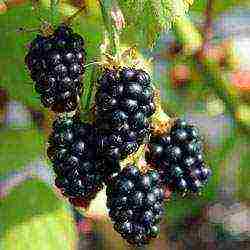 Blackberries are one of the closest relatives of raspberries, they are often grown on their own plots. Among the many varieties, the Black Satin Blackberry is distinguished, which forms a strong bush with long shoots, grows up to 5-7 m. When describing the variety and its characteristics, the crop yield deserves special attention. Thanks to proper planting and competent care, more than 20 kg of large sweet and sour berries can be harvested from one bush. Photos of branches abundantly dotted with fruits and positive reviews indicate the popularity of the variety among amateur gardeners.
Blackberries are one of the closest relatives of raspberries, they are often grown on their own plots. Among the many varieties, the Black Satin Blackberry is distinguished, which forms a strong bush with long shoots, grows up to 5-7 m. When describing the variety and its characteristics, the crop yield deserves special attention. Thanks to proper planting and competent care, more than 20 kg of large sweet and sour berries can be harvested from one bush. Photos of branches abundantly dotted with fruits and positive reviews indicate the popularity of the variety among amateur gardeners.
Description Blackberry variety Black satin
A distinctive feature of the variety is the absolute absence of thorns. Up to 1.5-1.8 m long, young shoots grow up, and then they begin to tilt horizontally, spread along the ground. Black satin actively grows every year, which is interesting, no root growth and spreading over the site is observed.
Perennial blackberry bushes with strong shoots are covered with bright green trifoliate leaves. Only the blossoming flowers have a delicate lilac hue, then turn white. Black satin berries are large from 4 to 8 g, especially closer to the top, collected in hanging clusters of 13-15 pieces.The ripening period is the end of July-August, it can even last in September. The berries acquire a rich black color, shimmer in the sun.
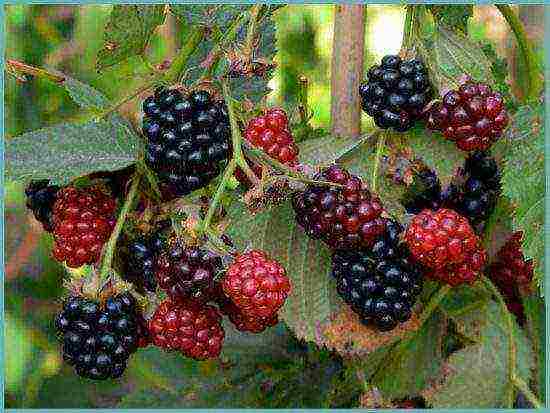
Garden blackberry fruits
The taste of Black satin is at its best: sweet, with almost imperceptible sourness, a very pleasant aroma. The yield of the blackberry is much higher than that of its relative, the usual raspberry.
Due to the later flowering, the forming ovary cannot be affected by spring frosts; it tolerates heat and lack of rain more easily. With sufficient moisture and proper care, larger, sweeter berries grow. Old blackberry bushes also bear fruit actively, but the harvested crop is noticeably smaller than that of young plantings.
Growing blackberries in the garden means providing yourself with a wide range of important vitamins and minerals such as B1, B2, B3, B9, E, K, PP and others. It is known that in terms of the amount of vitamin C, berries are even superior to oranges. Nicotinic acid, contained in blackberries, has anti-allergic properties, improves carbohydrate metabolism, is indicated for diabetes, liver and heart disorders, diseases of the gastrointestinal tract, poorly healing wounds. Calcium, iron, magnesium, manganese, copper, phosphorus are beneficial for the health and proper functioning of the entire human body.
Blackberries are a source of natural antioxidants that slow down aging, have an anti-inflammatory effect, and remove excess fluid from tissues. Leaves and fruits are used to prepare decoctions that improve digestion, speed up metabolism, which is especially useful for obese people. Boiled blackberry twigs are good for neuroses and heart problems.
Attention! With caution, blackberries should be used for people with allergies, which is manifested by a feeling of nausea, digestive problems, indigestion; kidney problems; diseases of the stomach, small intestine (it is preferable to drink fresh blackberry juice, with high acidity - a maximum of a glass per day).
Planting Blackberry Black Satin
The best place to plant is in a sunny area or partial shade. Lack of light can seriously affect productivity, and all the strength of the bush will go to the growth of new shoots. Keep in mind that the choice of open space threatens with damage to the branches; blackberries will not be able to grow normally due to bad weather.
Too dense soil, poor aeration, will most likely lead to rotting of the root system. Blackberry Black satin feels great in a loose, ventilated, loamy soil with low acidity.
It is necessary to engage in transplanting and reproduction of blackberries before flowering or after harvesting. The ideal option is in the spring, when there is no threat of sudden frosts. When choosing an acceptable site, shoots practically creeping on the ground should be taken into account, which in the second year need a garter.
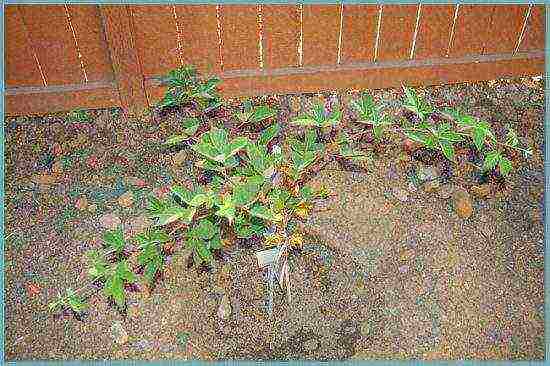
Young blackberry bush Black satin
It is a good idea to plant a blackberry near a fence or some place where it is convenient to build a support. Black satin is a powerful large variety, so a competent planting assumes that the distance between the bushes is not less than 1.5 m, preferably more, about 2 m, and the rows should be placed 2-2.5 m apart. If there is a solid fence near the blackberry, 1 m retreat from it so that the bushes are not in the shade.
Pits for seedlings about half a meter deep, 45 × 45 cm in size are usually dug in advance, they are poured into them, mixed with earth:
- 3-4 kg of compost or humus;
- 150 g superphosphate;
- 50 g of potassium salt.
Before planting a bush, it is recommended to treat it with special phytohormones for rapid rooting and accelerated growth. The root collar is not placed in the ground deeper than 3-4 cm. A hole with a small threshold is formed around the seedling so that water does not spread around, and the plant is well watered.
Features of caring for blackberries Black satin
Caring for a blackberry is quite simple, it needs regular moderate watering, loosening the soil, fertilizing, pruning excess shoots and molding. Black satin tolerates heat well, but if you want to get a good harvest in the form of large sweet berries, you need to make sure that the soil does not dry out. Periodically, the ground near the bushes is loosened.
Abundant fruiting can be expected from young shoots as early as next year. They also start wrapping around blackberry twigs and tying them to a support after a year. The simplest version of a trellis for Black satin is a wire stretched in several horizontal rows through posts installed every 4-5 m. The lower wire is located at a height of 75-80 cm from the ground, next 50 cm higher. The posts should go into the ground to a depth of at least 70 cm. It is very easy to build this option yourself.
Advice. Blackberry shoots grow up to 5-7 m, given that they will have to be covered for the winter, take care of this in advance, use the support to position them in the right direction before they become tough and begin to break.
In the first year after planting, pruning is not performed, all inflorescences are removed so that the plant can actively form a root system, frozen branches, as well as branches broken after winter. The next year, the shoots are shortened to 1.6-1.9 m, then a lot of ovary is formed. In late spring-early summer, bushes with a large number of young twigs are thinned out, leaving up to 10 healthy, medium-length and thick, cut off 7-10 cm tops. New shoots must be attached to the bottom row of the support. When the crop is harvested, the branches are cut to the ground, making room for young shoots that will begin to bear fruit the next season.
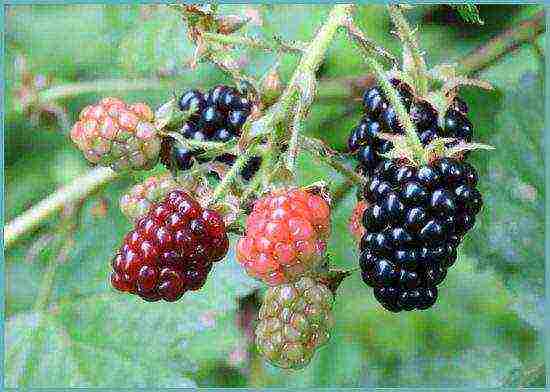
Monitor soil moisture
If the blackberry bush gave few replacement shoots, it is allowed to leave the best of the old, the yield from this significantly decreases. Timely pruning of excess, spoiled shoots, proper feeding, sufficient watering will help the blackberry to grow actively and bear fruit well.
Collecting Black satin berries from bushes must be done on time. Too overripe, overripe become soft, quickly deteriorate, completely unsuitable for transportation. At an earlier stage, of course, the blackberry tastes more sour. Harvested berries are also poorly stored, so they will have to be processed as quickly as possible, preferably within a day.
For shelter for the winter, the shoots are gently tilted to the ground, tied in bunches, and fixed with hooks. Suitable as a bedspread:
- non-woven agrofiber;
- sheets of roofing material;
- film;
- synthetic winterizer;
- fallen leaves, tops.
When warming blackberries for the winter, you should make sure that they do not rot, because of which the roots, shoots with buds will begin to rot, and with a sharp cold snap they will freeze. Therefore, it is not recommended to use film and synthetic winterizer for the southern regions.
Blackberry Black satin bears fruit with aromatic, tasty, incredibly healthy berries that are good fresh and for preservation. With proper care, an adult bush can give 15-20 kg of harvest per season, which you can use yourself and send for implementation.
Blackberry Black satin: video
Growing blackberries: photo
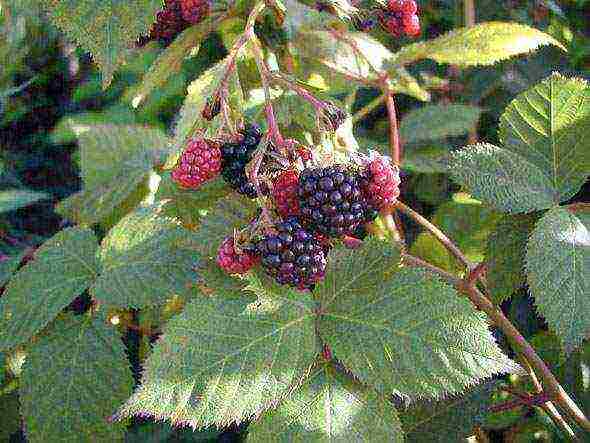
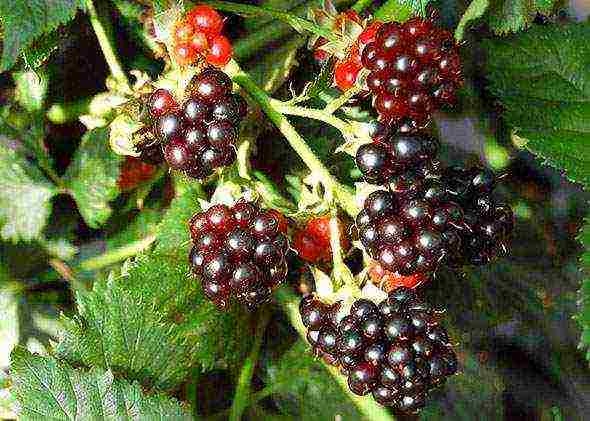
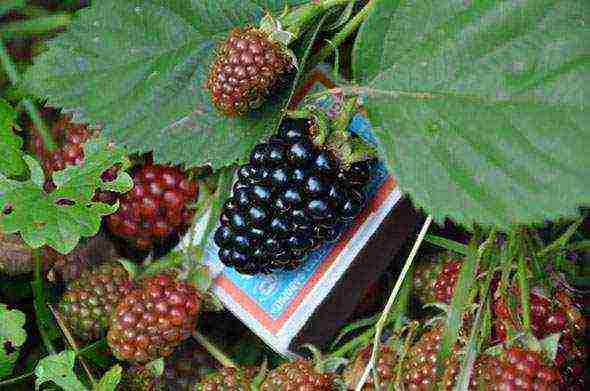
The fruits of the Black Satin Blackberry are similar in color to black silk, for which the variety got its name. Characteristics of the Black Satin variety
A distinctive feature of the Black Satin variety is the absence of thorns. Young shoots are bright green in color, but as they grow, they turn brown, which creates a beautiful contrast to the green leaves. Bushes give annual growth, root growth is absent.
The first flowering begins in late May or early June. Delicate purple flowers turn white as they grow. The variety is fast growing, mature bushes reach 7 meters in height. At first, the branches grow vertically, but when the bush grows, they change direction like creeping plants.
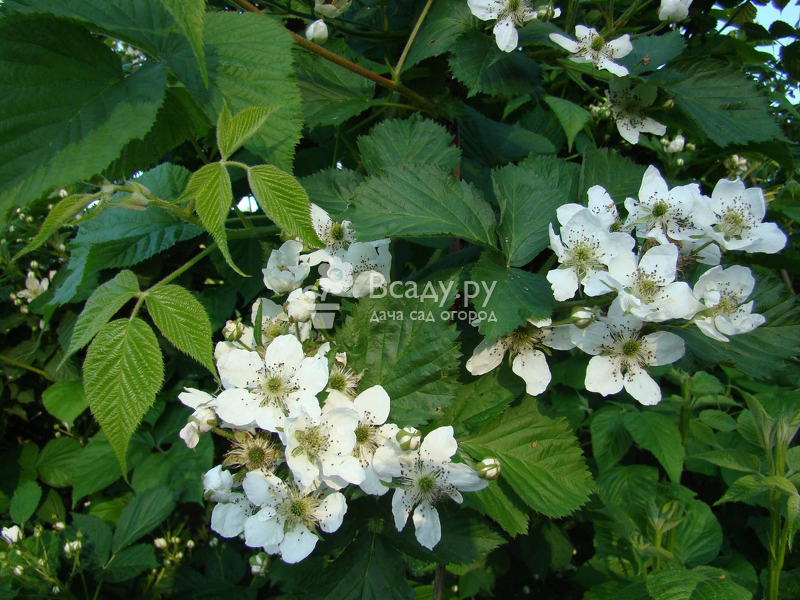 A feature of Black Satin is a change in the color of flowers from purple to pale white
A feature of Black Satin is a change in the color of flowers from purple to pale white
Black Satin means black silk and the berries fully justify the name of the variety. Ripe glossy fruits resemble silk fabric, the shape is rounded, slightly elongated. The approximate weight of one berry is 4 grams, the largest ones can weigh 8-10 grams.
Ripening begins at the end of July and lasts until the end of October. The berries have a pleasant taste with a slight sourness. With proper watering and care, you can achieve maximum yield and improve taste (increase sugar content). From an adult bush, you can collect up to 20 kg of berries per season.
Advantages and disadvantages of the variety
The variety has many benefits. Due to the deep root system, the plant tolerates drought well. The shrub feels equally well both in the sun and in partial shade.
Blackberry Black Sateen does not spread over the site. This feature is important for gardeners who create various compositions from plants. The variety is resistant to many pests and diseases, therefore, the use of chemicals during cultivation is not required.
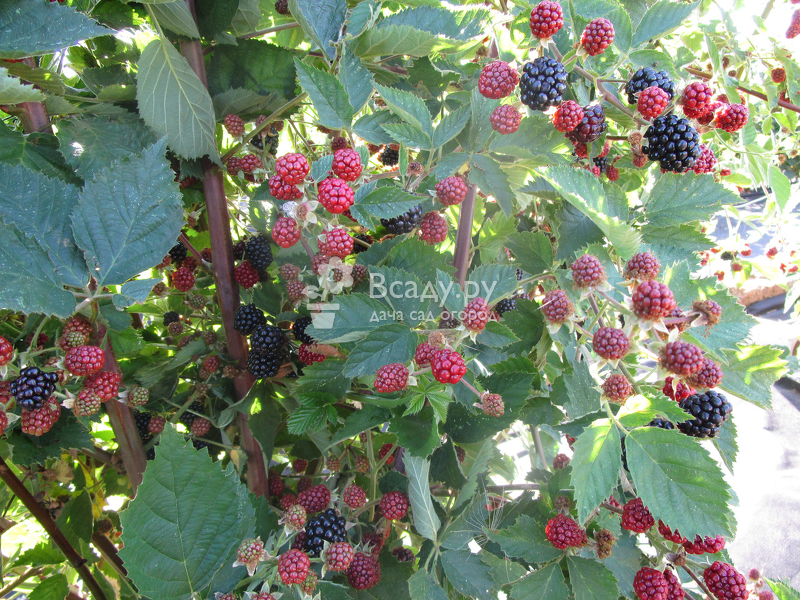 Blackberry Black Satin is a tall perennial plant that is distinguished by the absence of thorns and decorative qualities
Blackberry Black Satin is a tall perennial plant that is distinguished by the absence of thorns and decorative qualities
The absence of thorns greatly facilitates the process of picking berries. The crop can be obtained as early as the second year after planting. The entire period of fruiting, the ripening of berries goes on almost continuously. On one brush, you can find ripe fruits, ovary and flowers. Even after a full harvest, the next day the plant will give a new offspring.
Berries are not only pleasant to the taste, but also healthy. They contain many vitamins and minerals, and the leaves are used in folk medicine for the preparation of decoctions, teas, and infusions.
Ripening of Black Satin berries occurs throughout the entire fruiting period
The Black Satin variety has some disadvantages:
- It is not used by landscape designers due to the stiffness of the shoots. They break under the influence of mechanical force, so it is almost impossible for the plant to give the desired shape.
- It is important to harvest on time - if you miss the deadline, the berries become tasteless, soft, and rot.
- The fruits do not have good keeping quality and transportability. The harvested crop should be used during the day.
It is recommended to tie up young shoots so that they remain horizontal. This must be done before they acquire the characteristic rigidity. Otherwise, the bush grows too tall - it becomes inconvenient for harvesting and for leaving.
Blackberry Black Satin - planting and care
Blackberries of this variety prefers loose black soil, does not like excess moisture. Stagnant water can lead to decay of the rhizome. The plant grows well in the shade, but the best growth is noted in sunny areas, barred from the wind. It is not recommended to choose saline and limestone soils for cultivation.
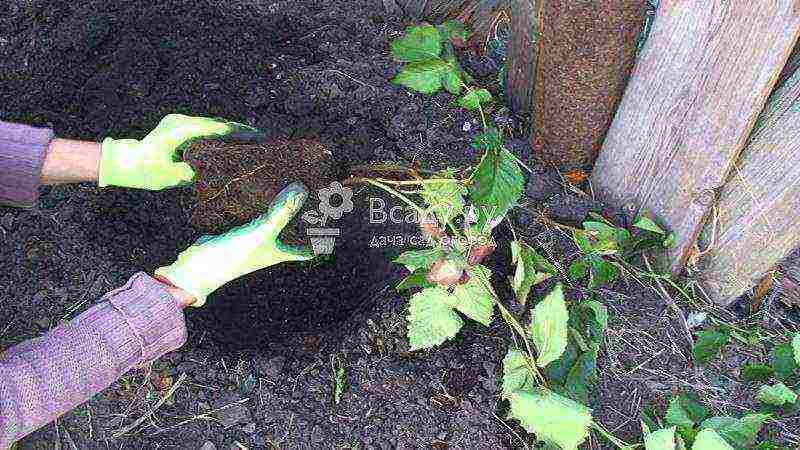 When choosing a place for planting Black Satin blackberries, keep in mind that they do not like winds and excess moisture
When choosing a place for planting Black Satin blackberries, keep in mind that they do not like winds and excess moisture
The optimal time for planting blackberries in the ground is early spring. Can be planted in autumn - at the end of September. In this case, young shrubs must be carefully wrapped for the winter.
The plant should be transplanted to a permanent place before the growing season - in May and June. The soil is preliminarily prepared:
- holes are dug up to half a meter deep, observing the distance between the bushes 1-2 meters;
- landing sites are watered abundantly with water;
- seedlings are carefully placed in pits and sprinkled with fresh soil;
- the soil near the plant should be mulched with butcher or large sawdust;
- 2-3 buds are left on young shoots, the rest is cut off.
To get a good harvest of sweet berries, you need to follow the basic rules of care. After planting, the blackberries are tied up, and the shoots are directed so that it is convenient to tie them to the supports, taking into account the flexibility of the branches and their further development.
The growth of the branches of the blackberry must be guided so that it does not grow too tall.
The soil around the seedlings should be loosened and weeded regularly. From the second year, the bushes are fertilized with nitrogen fertilizers. Blackberries love water, so regular watering is essential. One bush requires about 1-2 buckets of water.
Black Satin is resistant to diseases and parasites, but to prevent blackberry mites, it should be sprayed with horsetail infusion. In the first year of life, there is no need to fertilize shrubs. The first feeding begins from the second year of life.
You will find general rules for caring for blackberries in our material.
Pruning and propagation of culture
There are a lot of breeding options for the Black Satin variety:
- seedlings;
- layering;
- seeds;
- rooting;
- petioles.
The most productive and easiest way is to root non-lignified tops. The procedure is carried out in July or August in this way:
- choose healthy shoots about 30 cm long;
- dig a furrow in a suitable place with a depth of 20 cm;
- the branches are carefully bent and tied up so that their tops touch the ground;
- prepare small oblong pits 5-10 cm deep;
- the tops are laid and buried in the trenches so that the soil level above them is 10 cm.
In order for the bush to develop evenly, regular pruning should be carried out. The first shoots are cut in the year of planting in the summer with pruning shears. In a two-year-old shrub, lateral branches are formed, shortening them to 40 cm so that the plant receives enough light.
Formative Blackberry Pruning Black Satin
The shrub rhizomes tolerate cold well, but the upper part can freeze at low temperatures. Therefore, it is recommended to cover the plants for the winter.
Blackberry Black Satin - variety reviews
Reviews of gardeners about the variety are mostly positive. Brambles celebrate the stability of the harvest. Berries do not become smaller over time, despite heavy loads.
One of the advantages of culture is ease of maintenance. Even if you visit the dacha only on weekends, and there is no opportunity for regular watering, you can count on a good harvest.
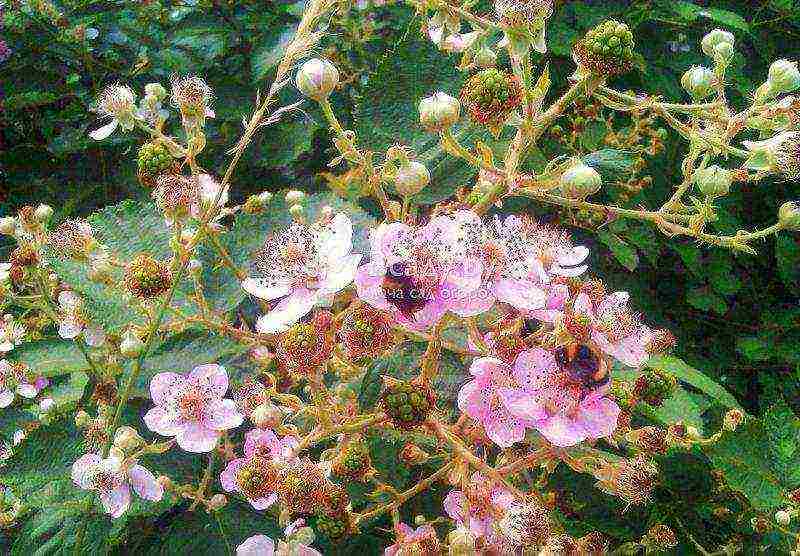 The beginning of flowering of blackberry Black Satin
The beginning of flowering of blackberry Black Satin
I really love green fences, so I immediately appreciated the decorative qualities of Black Satin blackberries. Plants planted near the fence perform the function of a living curtain, they look very natural and impressive. And delicious berries for me are just a nice bonus.
Marianna, 30 years old, Moscow
I am growing Black Satin for sale and am very pleased with the result. Blackberry has an excellent presentation and a high yield. This type is well suited for commercial farms, but it is important to establish sales in advance, since it is very poorly stored.
Egor, 40, Krasnodar
Blackberry Black Satin has been growing in my country house for 3 years already. I grow shrubs vertically, without spreading branches to the side, and tie them to a net stretched near the gazebo - like grapes. My grandchildren really like the big tasty berries, and I like to relax in the shade of the bramble he creates.
Raisa, 62 years old, Tyumen
Vertical cultivation of Black Satin to create shade in the gazebo
I really like Black Satin. But it is important to remember that berries are not suitable for long-term storage. I try to harvest in such a way as to distribute it in one day. Harvest with sugar, dry, freeze, make compotes and jams.
Natalia, 42, Kaliningrad
I discovered this blackberry variety 5 years ago. I really like that the berries do not shrink over the years. Every season, the bushes delight me with a bountiful harvest.
Tatiana, 38, Penza
Outcome
Blackberry Black Satin is an unpretentious perennial culture that will decorate any garden, thanks to its excellent decorative properties. Observing the basic rules of care, you will get a beautiful green area on the site, and a stable tasty harvest of healthy berries.
